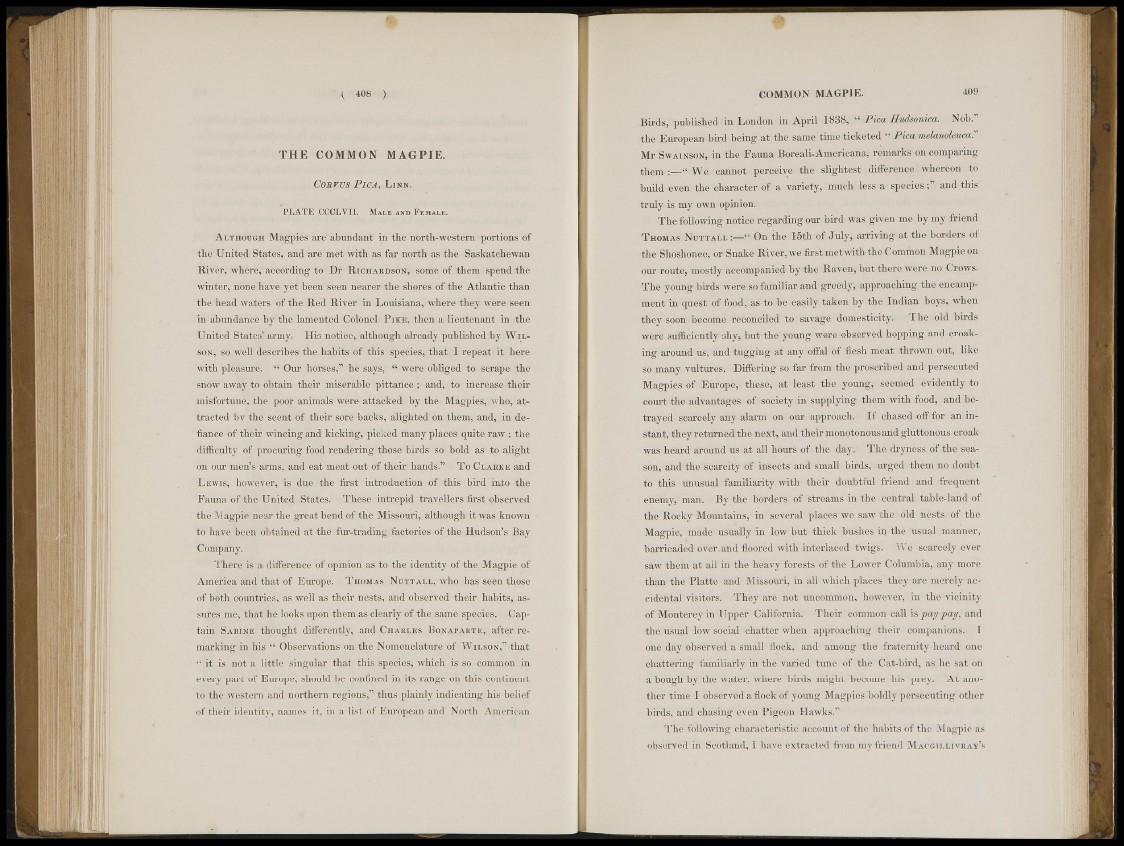
( 408 );
T H E C OMMO N MAGPIE.
CORVUS PICA, LINN,
' P L A T E GCCLYII. MALE AND FEMALE.
ALTHOUGH Magpies are abundant in the north-western portions of
the United States, and are met with as far north as the Saskatchewan
River, where, according to Dr RICHARDSON, some of them spend the
winter, none have yet been seen nearer the shores of the Atlantic than
the head waters of the Red River in Louisiana, where they were seen
in abundance by the lamented Colonel PIKE, then a lieutenant in the
United States' army. His notice, although already published by WILSON,
so well describes the habits of this species, that I repeat it here
with pleasure. " Our horsesf' he says, " were obliged to scrape the
snow away to obtain their miserable pittance; and, to increase their
misfortune, the poor animals were attacked by the Magpies, who, attracted
by the scent of their sore backs, alighted on them, and, in defiance
of their wincing and kicking, picked many places quite raw ; the
difficulty of procuring food rendering those birds so bold as to alight
on our men's arms, and eat meat out of their hands.'" To CLARKE and
LEWIS, however, is due the first introduction of this bird into the
Fauna of the United States. These intrepid travellers first observed
the Magpie near the great bend of the Missouri, although it was known
to have been obtained at the fur-trading factories of the Hudson's Bay
Company.
There is a difference of opinion as to the identity of the Magpie of
America and that of Europe. THOMAS NUTTALL, who has seen those
of both countries, as well as their nests, and observed their habits, assures
me, that he looks upon them as clearly of the same species. Captain
SABINE thought differently, and CHARLES BONAPARTE, after remarking
in his " Observations on the Nomenclature of WILSON,11 that
" it, is not a little singular that this species, which is so common in
every part of Europe, should be confined in its range on this continent
to the western and northern regions,11 thus plainly indicating his belief
of their identity, names it, in a list of European and North American
C O M M O N MAGPIE. 409
Birds, published in London in April 1838, " Pica Hudsonica. Nob.11
the European bird being at the same time ticketed " Pica melanoleuca?
Mr SWAINSON, in the Fauna Boreali-Americana, remarks on comparing
them We cannot perceive the slightest difference whereon to
build even the character of a variety, much less a species and this
truly is my own opinion.
The following notice regarding our bird was given me by my friend
THOMAS NUTTALL :—" On the 15th of July, arriving at the borders of
the Shoshonee, or Snake River, we firstmetwith the Common Magpie on
our route, mostly accompanied by the Raven, but there were no Crows.
The young birds were so familiar and greedy, approaching the encampment
in quest of food, as to be easily taken by the Indian boys, when
they soon become reconciled to savage domesticity. The old birds
were sufficiently shy, but the young were observed hopping and croaking
around us, and tugging at any offal of flesh meat thrown out, like
so many vultures. Differing so far from the proscribed and persecuted
Magpies of Europe, these, at least the young, seemed evidently to
court the advantages of society in supplying them with food, and betrayed
scarcely any alarm on our approach. If chased off for an instant,
they returned the next, and their monotonous and gluttonous croak
was heard around us at all hours of the day. The dryness of the season,
and the scarcity of insects and small birds, urged them no doubt
to this unusual familiarity with their doubtful friend and frequent
enemy, man. By the borders of streams in the central table-land of
the Rocky Mountains, in several places we saw the old nests of the
Magpie, made usually in low but thick bushes in the usual manner,
barricaded over , and floored with interlaced twigs. We scarcely ever
saw them at all in the heavy forests of the Lower Columbia, any more
than the Platte and Missouri, in all which places they are merely accidental
visitors. They are not uncommon, however, in the vicinity
of Monterey in Upper California. Their common call is pay pay, and
the usual low social chatter when approaching their companions. I
one day observed a small flock, and among the fraternity heard one
chattering familiarly in the varied tune of the Cat-bird, as he sat on
a bough by the water, where birds might become his prey. At another
time I observed a flock of young Magpies boldly persecuting other
birds, and chasing even Pigeon Hawks.11
The following characteristic account of the habits of the Magpie as
observed in Scotland, I have extracted from my friend MACGILLIVRAY'S